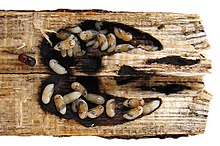Ambrosia beetle
Ambrosia beetles are beetles of the
Classification and diversity

Until recently ambrosia beetles have been placed in independent families Scolytidae and Platypodidae, however, they are in fact some of the most highly derived
Ambrosia beetles are an

The symbiotic relationship
Beetles and their
A few dozen species of ambrosia fungi have been described, currently in the genera
Evolutionary origin
During their evolution, most scolytid and platypodid weevils became progressively more or less dependent on fungi regularly co-habiting dead trees. This evolution had various outcomes in different groups:
- Some
- Many of phloem-feeding bark beetles use phloem-infesting fungi as an addition to their diet. Some phloeophages became dependent on such a mixed diet and evolved mycangia to transport their symbionts from maternal trees to newly infested trees.[13] These beetles are called mycophloeophages.
- Ambrosia beetles and ambrosia fungi are thus only one end of the spectrum of the weevil-fungus association, where both the beetle and the fungus became completely dependent on each other.[14]
Impact on forests
The vast majority of ambrosia beetles colonize dead trees, and have minor or no economic effect. A few species are able to colonize living stressed trees (Xylosandrus).[15] A few species are able to attack live and healthy trees, and those can reach epidemic proportions in non-native, invaded regions (Xyleborus glabratus, Euwallacea fornicatus[16]).
Beetle species that readily colonize lumber, such as sawlogs, green lumber, and stave-bolts, often cause region-specific economic loss from the pinhole and stained-wood defects caused by their brood galleries. In Northern USA and Canada, conifer logs are attractive to Trypodendron lineatum (Oliv.) during the spring swarming flight (Dyer 1967).[17] Previous studies showed that short log sections become attractive more rapidly than corresponding long logs.
See also
- Laurel wilt disease
- Forest pathology
- Euwallacea fornicatus
- Xyleborus glabratus
References
- .
- PMID 29632193.
- ^ PMID 27860522.
- doi:10.1071/IT00024.
- PMID 12396590.
- PMID 19365072.
- ISBN 978-0-12-417156-5.
- S2CID 26352287.
- ISBN 978-0-89054-156-2.
- S2CID 11844858.
- PMID 15012312.
- PMID 20822444.
- ^ Klepzig, Kier D.; Six, D. L. (2004). "Bark Beetle-Fungal Symbiosis: Context Dependency in Complex Associations". Symbiosis. 37: 189–2005.
- ISBN 978-0-08-098453-7.
- S2CID 54556122.
- S2CID 67808629.
- ^ Dyer, E. D. A. (1967). "Relation of attack by ambrosia beetle (Trypodendron lineatum (Oliv.)) to felling date of spruce in central British Columbia". Bi-monthly Research Notes. 23 (2): 11.
External links
- Images and information on the Ambrosia Symbiosis at the University of Florida.
- The MSU HISL database contains a worldwide species list of Xyleborini, a major group of ambrosia beetles, from the Catalog of Scolytidae and Platypodidae of S.L. Wood and D.E. Bright (1992)
- A USDA-sponsored information resource and key Archived 2018-12-08 at the Wayback Machine to the world genera of Xyleborini
- American Bark and Ambrosia Beetles
- More information on ambrosia beetle social behaviour and fungiculture on [1]
- Farewell to taco topping? The effects of the Redbay ambrosia beetle and laurel wilt disease
- Ambrosia beetles on the UF / IFAS Featured Creatures Web site
Bibliography
- van de Peppel, L. J. J.; Aanen, D. K.; Biedermann, P. H. W. (April 2018). "Low intraspecific genetic diversity indicates asexuality and vertical transmission in the fungal cultivars of ambrosia beetles". Fungal Ecology. 32: 57–64. .
